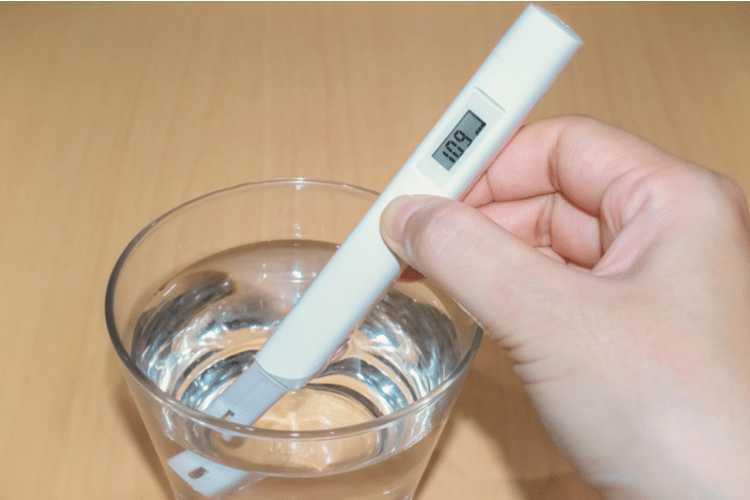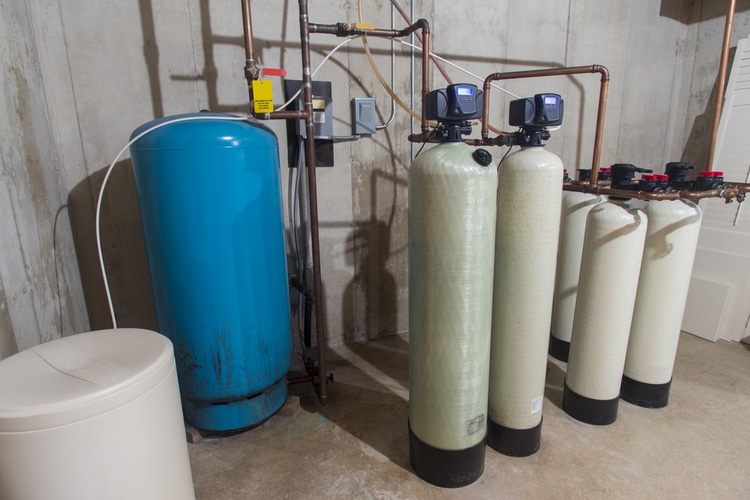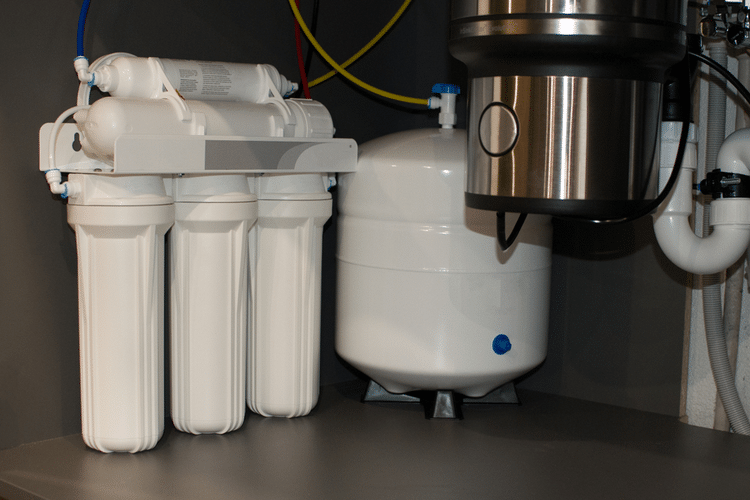How To Measure Water Hardness With Tds
If you've e'er turned on the tap and had something that looked (and smelled) a chip off, you lot were probable experiencing water with Total Dissolved Solids (TDS). TDS is simply a measure of all the dissolved solids in water.
But what does that mean for your everyday life? And how do you calculate information technology? So allow's take a closer look.
What Is TDS in H2o?

TDS stands for Total Dissolved Solids. Information technology measures the total corporeality of soluble minerals and salts in water. For instance, if you take a water pitcher with one mg/50 TDS, at that place is one mg/Fifty of dissolved minerals in your water pitcher.
What's important to know is that TDS isn't but a measure of the total corporeality of dissolved solids in water. Information technology also includes minerals, salts, and metals dissolved in the water.
So you can't just get TDS by calculation upward all the dissimilar kinds of dissolved solids – you need to calculate information technology separately for each type!
How Does TDS Get in Water?
There are three master ways TDS can go into your water: from the h2o itself, from the air, and the ground. For example, some cities and towns treat their h2o with chemicals to kill leaner and other harmful organisms.
These chemicals are called disinfectants. But these disinfectants can too end up getting into your water supply, especially if they're leftover afterwards the treatment procedure is done.
If you lot meet a lot of white sediment or foam in your water pitcher, there's chlorine or chloramine in your tap water. Chlorine makes tap h2o taste dandy (and smell keen), but information technology tin react with certain organic compounds to course substances like trihalomethanes (THMs).
These substances are not only unhealthy for you to drinkable, only they also have been linked to many serious health issues, including cancer and built disabilities.
List of Organic & Inorganic Total Dissolved Solids in Water
The following is a list of organic and inorganic total dissolved solids in water, organized by type.
Organic:
- Carbonates
- Bicarbonates
- Organic acids
- Amino acids
- Proteins
- Sugars
- Urea
Inorganic:
- Calcium
- Magnesium
- Sodium
- Potassium
- Chloride
- Sulfate
- Phosphate
- Carbon dioxide
While all water contains dissolved solids, the levels of these solids vary depending on the source. For case, groundwater typically has college levels of dissolved minerals, while surface water from rivers and lakes tends to have lower levels.
H2o that has been treated with a opposite osmosis system as well typically has very depression levels of dissolved solids.
Normal TDS of Drinking Water in PPM
The TDS values for unlike h2o sources vary depending on whether the water is naturally occurring or comes from a treatment facility. In that location are many means to measure TDS, with the most common being by a titration method.
Titration is done past mixing known amounts of distilled water with a solution containing dissolved solids. The amount of solid that dissolves into the solution is then adamant and compared to a standard reference table.
Aqueous solubility: carbon dioxide (CO), sulfate, chloride, potassium chloride, heavy metals, and radon can deliquesce in water; they are nowadays in small amounts that are usually non harmful to human health because they are rapidly removed from drinking water by filtration or activated carbon treatment.
These substances do non pose any threat to health because their concentration in drinking water is too low to cause whatsoever adverse health effects. In addition, some of these substances are naturally occurring and present in basis and surface water as a natural component of the water.
The EPA has gear up the highest contaminant levels for some contaminants in drinking h2o. The MCLs more often than not refer to residential employ, although the aforementioned MCL may be applied for non-residential utilise.
For example, the MCL for lead is 15 µg/50; MCLs are also prepare for other contaminants such every bit arsenic and radium.
Co-ordinate to the EPA, "the highest MCLG is the level of a contaminant in potable h2o that does not pose a substantial wellness risk."
Therefore, the EPA sets an MCLG based on the lowest level at which no adverse health furnishings are observed in people who drinkable large amounts of contaminated h2o over a long period.
For case, if it is determined that one mg/50 of atomic number 82 causes no adverse health effects in people who drink big amounts over a long menses, and so the MCLG for pb is fix at one mg/L.
How To Exam for Full Dissolved Solids (TDS)
The total dissolved solids (TDS) of h2o is the number of dissolved solids in a given volume of h2o. TDS is measured by weighing the water, heating information technology to a eddy, and measuring the weight of h2o subsequently information technology boils for one minute.
TDS can be used to summate total hardness and pH. Hardness is an indicator of whether minerals are present in the water. If minerals are present in loftier quantities, hardness will increase, and pH will decrease.
If minerals are absent or present in low amounts, hardness volition fall, and pH volition increase.
How Is TDS Measured?
TDS, or full dissolved solids, measures the combined content of all inorganic and organic substances contained in a liquid.
In guild to mensurate TDS, a sample of water is filtered to remove any suspended particles. So the residual is weighed to decide the dissolved solid content.
The well-nigh mutual method for measuring TDS is with a conductivity meter, which uses an electrical current to measure the ability of the h2o to conduct electricity. The higher the concentration of dissolved solids, the greater the electric conductivity.
Yous can also measure TDS with a refractometer, which uses the principles of refraction to decide the dissolved solid content. While both methods are accurate, conductivity meters are more commonly used due to their ease of apply and lower price.
Health Effects of Drinking High TDS Water
Drinking water is essential for good health, but not all water is created equal. For instance, water with a high concentration of dissolved solids, or TDS, tin can take agin health furnishings.
Ingesting high TDS water tin atomic number 82 to dehydration and gastrointestinal distress, as the trunk expends extra energy to process the solids.
In addition, loftier TDS water tin can damage tooth enamel and contribute to kidney stones. Furthermore, water with a loftier TDS level may incorporate harmful contaminants, including heavy metals and pesticides.
As a result, information technology is essential to be aware of the TDS level of your drinking water and take steps to filter out impurities, if necessary. By ensuring that you lot are drinking clean, safety water, yous can help forbid health problems and salvage money.
Can You lot Drink Zip TDS?
Zero TDS water is simply h2o with all of its dissolved solids removed. You can practice this through opposite osmosis, which uses a semi-permeable membrane to filter out impurities.
While zero TDS water is safe to drink, information technology can be less good for you than water with a moderate level of dissolved solids. Zero TDS water is unhealthy considering many of the minerals and nutrients removed forth with the dissolved solids are beneficial.
How Practice I Lower the Full Dissolved Solids in My Tap H2o?
If you accept a kitchen faucet, you can endeavor running the water for a few minutes. Running h2o will help remove some of the minerals from your tap water. If yous cannot exercise this, you tin can try boiling your tap water for about v minutes.
Humid water will also help remove some minerals and other substances from your h2o. However, you should non boil your drinking water for extended periods, as doing and then can harm it over time.
Can I Filter My Water?
There are many unlike filters that you can use to reduce the TDS in your tap water. Y'all can fifty-fifty get as far as installing one inside your abode or business concern if needed. The most mutual types of filters include:
Inline filters:
These are installed in line with your faucet and use a filter cartridge that is replaced every month. These filter out many different contaminants, but they typically simply filter out up to around 50-60 gallons of water.
Under-the-sink Filters:
These filters are installed under your sink and provide a large chapters. They filter out up to 300 gallons of water before needing to be replaced. These filters are usually more expensive than the inline type, just they tin can last for more extended periods.
Does Boiling Water Reduce TDS?
Boiling water does not remove all of the TDS from your water supply; however, it does remove some. This is why the EPA recommends that y'all boil tap water for at least one minute earlier drinking it.
Tin a Sand Filter Reduce TDS?
Sand filters tin reduce the TDS in your h2o supply past removing sediment, typically the most pregnant contributor to high levels of TDS in your water. All the same, sand filters tin can be difficult to clean and maintain.
Near commercially available models crave y'all to modify the sand every iii months manually. If you have a big family or a lot of guests over for dinner, this may not be practical for y'all.
Tin a UF Filter Remove TDS?
UF filter can remove virtually of the TDS from your water supply. UF filters finer eliminate TDS, and they are widely used in homes today. Still, UF filters practise non remove all contaminants from your h2o supply that other types of filtration systems remove.
The most common pollutants UF filters cannot remove are pharmaceuticals and hormones, so bottled water is commonly used.
Does a Nano Filter Reduce TDS?
UF filters are the most mutual type of water filter that you volition find in homes today. UF filters finer remove TDS from your water supply, only they practice not remove all contaminants from your water supply.
At that place are other types of filtration systems bachelor today that can remove TDS, but they are more expensive than UF filters. The most common types of filtration systems that yous will find in homes today include:
Water Softener:

Softeners work by removing calcium and magnesium ions from your water supply; eliminating calcium and magnesium results in soft water with a lower TDS level than what is naturally occurring in groundwater.
Water softeners also reduce fe and manganese levels, found at high concentrations in well water. You can use a water softener to reduce TDS levels if you have a well as your source of drinking water or if you live near areas with high levels of naturally occurring minerals. Water softeners are relatively inexpensive and easy to install.
Softeners piece of work by removing calcium and magnesium ions from your water supply. This results in soft water with a lower TDS level than what is naturally occurring in groundwater. Water softeners also reduce iron and manganese levels, constitute at high concentrations in well water.
You can employ a water softener to reduce TDS levels if you lot accept a well equally your source of drinking water or if you live near areas with high levels of naturally occurring minerals.
Water softeners are relatively inexpensive and piece of cake to install. Distillation – Distillation is the process of boiling water until it turns into steam, which then condenses back into liquid form under pressure, leaving the impurities behind.
Distillation

Distillation is an constructive way to remove contaminants such as chlorine, merely it does not remove all of the pollutants present in your drinking water supply. The UF filter removes nigh of these contaminants, while distillation removes some but not all of them.
Distillation is the process of boiling h2o until information technology turns into steam, which condenses back into liquid course under pressure, leaving the impurities behind. Distillation is an effective manner to remove contaminants such as chlorine, just it does non remove all of the pollutants present in your drinking water supply.
The UF filter removes most of these contaminants, while distillation removes some simply not all of them.
Reverse Osmosis

Reverse Osmosis (RO) uses a purer class of salt than distillation and extracts metals and other impurities from drinking water supplies.
RO is a good choice if you lot have many contaminants in your water supply or if you live near areas with high levels of naturally occurring minerals. However, RO systems are relatively expensive and require a lot of maintenance.
However, RO systems are relatively expensive and require a lot of maintenance. Spring Water – Spring water is water that has been purified and stored in a natural hugger-mugger aquifer. Information technology does not contain many impurities, just some residual minerals may cause mineral buildup over time.
Does Water Softener Reduce TDS?
Water softeners do not reduce TDS considering TDS is not a measure out of hardness. TDS measures the number of dissolved solids in water, and hardness is simply i type of dissolved solids.
Water softeners increase the number of dissolved solids in your water by replacing calcium and magnesium with sodium.
What Is The Difference Between TDS and PH?
TDS is a measurement of the total dissolved solids (TDS) in h2o, while PH is a measurement of the acidity or alkalinity of the water. Therefore, the TDS level in your water supply volition exist higher than the PH level if it contains more TDS.
The PH level will be higher than the TDS level if it contains more alkalinity. Therefore, if your water supply is high in both TDS and PH, yous may take many minerals in your water supply.
How To Measure Water Hardness With Tds,
Source: https://waterdefense.org/water/contaminants/tds/
Posted by: thompsoncutdomplad.blogspot.com


0 Response to "How To Measure Water Hardness With Tds"
Post a Comment